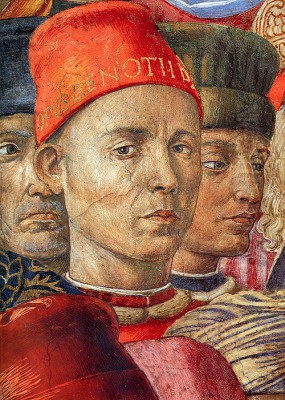
Benozzo Gozzoli stands as one of the most delightful and prolific narrative painters of the Early Italian Renaissance. Active primarily in Florence and Tuscany during the vibrant 15th century, he captured the spirit of his age through detailed, colourful, and engaging fresco cycles. Known for his keen observation, decorative flair, and masterful storytelling, Gozzoli translated religious narratives and contemporary life into visually rich tapestries that continue to enchant viewers today. His proper name was Benozzo di Lese di Sandro, but he is universally known to art history as Benozzo Gozzoli. Born around 1420 in Florence, he lived a long and productive life, passing away in Pistoia in 1497.
Florentine Beginnings and Early Training
Born near Florence around 1420, Benozzo di Lese was the son of a tailor named Lese di Sandro. His early artistic inclinations led him into the bustling world of Florentine workshops. A pivotal moment in his formative years was his apprenticeship and collaboration with the renowned sculptor Lorenzo Ghiberti. Between 1444 and 1447, Gozzoli assisted Ghiberti on the magnificent bronze doors for the Florence Baptistery, known as the "Gates of Paradise." This experience undoubtedly honed his skills in composition, narrative clarity, and working within a large-scale, collaborative project – skills that would prove essential for his later career as a fresco painter.
Following his work with Ghiberti, Gozzoli entered the orbit of another towering figure of the Early Renaissance, the painter Fra Angelico. This association marked a crucial phase in his development. He became Fra Angelico's assistant and collaborator, absorbing the master's luminous color palette, graceful figural style, and serene spirituality. This period saw him travel and work on significant commissions alongside Angelico, laying the groundwork for his own independent artistic voice.
Collaboration with Fra Angelico: Rome and Orvieto
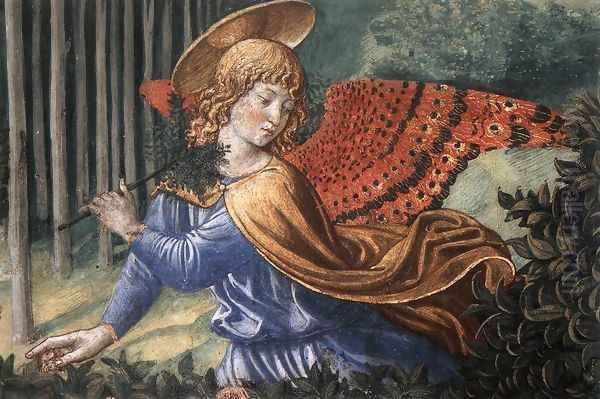
The partnership with Fra Angelico provided Gozzoli with invaluable experience and exposure. Around 1447, he accompanied Angelico to Rome, where they worked on frescoes for Pope Eugene IV in the Vatican. Though these works are now lost, the experience of working at the heart of the Church was significant. They later collaborated on frescoes in the Chapel of San Brizio in Orvieto Cathedral, a project Fra Angelico began and which was later famously completed by Luca Signorelli.
Perhaps their most notable surviving collaboration is in the Niccoline Chapel in the Vatican, decorated for Pope Nicholas V between approximately 1447 and 1449. Here, Gozzoli worked closely with Fra Angelico on scenes from the lives of St. Stephen and St. Lawrence. While Fra Angelico's guiding hand is evident, Gozzoli's emerging personality can be discerned in the attention to detail and the lively depiction of secondary figures and architectural settings. An exquisite panel painting, the Annunciation now housed in the Vatican Museums (Pinacoteca Vaticana), dating from around 1450-1452, likely served as a predella piece and showcases the delicate style influenced by Angelico from this period.
Forging an Independent Path: Umbria and Montefalco
By 1449-1450, Gozzoli began to establish himself as an independent master. He left Fra Angelico's direct employ and sought commissions further afield, initially finding success in Umbria. His first major independent fresco cycle was undertaken in Montefalco, a town that clearly appreciated his talents. Between 1450 and 1452, he decorated the choir of the Church of San Francesco with scenes from the Life of St. Francis.
This extensive cycle demonstrates Gozzoli's growing confidence and narrative skill. He depicted the key events of the saint's life with clarity, incorporating detailed landscapes and contemporary costumes. The work shows the lingering influence of Fra Angelico's sweetness but also reveals Gozzoli's own burgeoning interest in anecdotal detail and descriptive richness. This commission solidified his reputation and paved the way for even more prestigious projects upon his return to his native Florence. He also painted other works in Montefalco, further cementing his presence in the region during this period.
A Masterpiece for the Medici: The Magi Chapel
Gozzoli's return to Florence culminated in his most famous and celebrated commission: the decoration of the private chapel in the Palazzo Medici (now Palazzo Medici-Riccardi). In 1459, Piero de' Medici entrusted Gozzoli with painting the chapel's walls with the Procession of the Magi. This work stands as a quintessential example of Early Renaissance Florentine art, perfectly blending religious narrative with a magnificent display of Medici power and prestige.
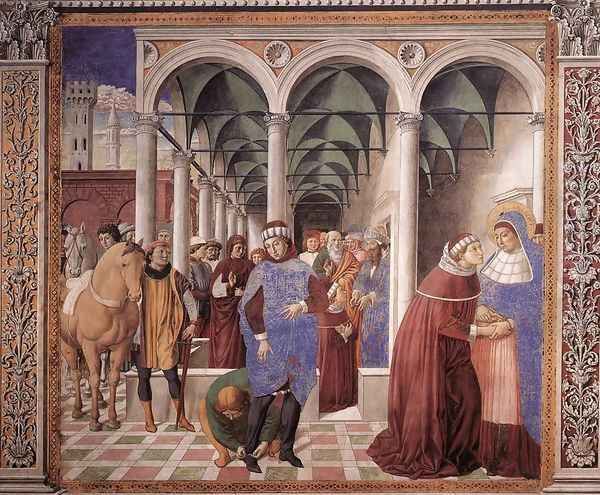
The frescoes wrap around the small chapel space, creating an immersive experience. Gozzoli depicted the journey of the three Magi towards Bethlehem, not as a humble biblical event, but as a splendid, festive pageant filled with sumptuously dressed figures, exotic animals, and a meticulously detailed landscape inspired by the Tuscan hills. The work is renowned for its vibrant colours, intricate patterns on fabrics, and the sheer abundance of life packed into every scene. It combines sacred history with elements that feel almost like a courtly fairy tale.
Portraits and Pageantry in the Magi Chapel
What makes the Magi Chapel frescoes particularly fascinating is Gozzoli's inclusion of numerous portraits of the Medici family members and their allies, seamlessly integrated into the Magi's procession. Lorenzo the Magnificent is often identified as the young king on horseback, while his father Piero and grandfather Cosimo de' Medici are also present, alongside other prominent Florentines and even visiting dignitaries. This blending of the sacred and the secular was characteristic of the period, showcasing the patrons' piety while simultaneously celebrating their worldly status.
Gozzoli also included a self-portrait within the bustling crowd. He depicts himself looking directly out at the viewer, wearing a red cap inscribed with "OPUS BENOTII" (The work of Benozzo). This confident assertion of authorship highlights the growing status of artists during the Renaissance. The entire cycle is a testament to Gozzoli's skill in managing complex compositions, his eye for detail, and his ability to cater to the sophisticated tastes of Florence's leading family. It remains one of the best-preserved and most evocative interiors of the 15th century.
Flourishing Career: San Gimignano and Other Works
Following the triumph of the Medici Chapel, Gozzoli's services were in high demand. He moved to the picturesque hill town of San Gimignano in 1464, where he undertook another major fresco cycle. Between 1464 and 1465 (or slightly later, sources vary, sometimes citing 1467-1469), he painted seventeen large scenes from the Life of St. Augustine in the choir of the Church of Sant'Agostino. This cycle, while perhaps less opulent than the Magi Chapel, showcases his mature narrative abilities and his skill in depicting complex theological and biographical events with clarity and human interest.
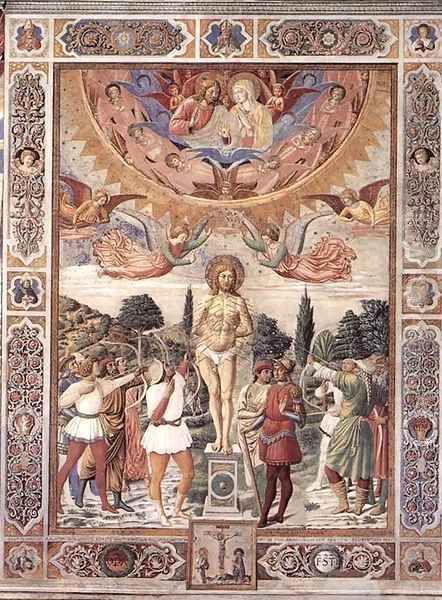
During his time in San Gimignano, Gozzoli also completed other significant works. In 1465, he painted a powerful fresco of the Martyrdom of St. Sebastian in the Collegiata di Santa Maria Assunta (the town's main collegiate church), demonstrating his ability to handle dramatic and emotionally charged subjects. A panel painting from this period, the Madonna and Child with Saints dated 1461, now in the National Gallery, London, further exemplifies his output during these productive years, showcasing his characteristic clear colours and detailed rendering outside of fresco. An earlier Madonna and Child with Saints dated 1439, mentioned in relation to exhibitions, points to his long career even before his most famous works.
The Grand Narrative: Pisa's Camposanto
Perhaps Gozzoli's most ambitious undertaking began in 1469 when he was commissioned to decorate a vast section of the wall in the Camposanto Monumentale (the monumental cemetery) adjacent to the Pisa Cathedral. This enormous project involved painting a series of frescoes depicting stories from the Old Testament, starting from the time of Noah and continuing through the lives of the Patriarchs and Moses. Gozzoli worked on this cycle intermittently for about sixteen years, completing a large number of scenes (sources suggest around 24 or 26 originally).
The Camposanto frescoes represented the culmination of Gozzoli's narrative skills on an epic scale. He filled the expansive walls with bustling scenes, detailed landscapes, and a multitude of figures. Notable surviving (though damaged) scenes include the Harvest and Drunkenness of Noah, the Building of the Tower of Babel, the Story of Abraham, and episodes from the life of Moses. These works allowed Gozzoli ample scope for his love of anecdotal detail, depictions of animals, and elaborate architectural settings.
Challenges and Legacy of the Camposanto
The sheer scale of the Camposanto project was immense, covering a huge surface area. Gozzoli employed numerous assistants to complete the work, yet his guiding vision is evident throughout. The frescoes were celebrated in their time and considered among his greatest achievements. Giorgio Vasari, the 16th-century biographer of artists, praised Gozzoli's diligence and the richness of the Camposanto cycle.
Tragically, the Camposanto suffered devastating damage during World War II. An Allied bombing raid in 1944 caused fires that severely harmed most of the frescoes, including Gozzoli's cycle. Decades of painstaking restoration work have followed, attempting to salvage what remains. While much of the original colour and detail is lost, the surviving sinopie (preparatory drawings on the plaster layer beneath the final fresco) and fragments give a sense of the original grandeur and complexity of Gozzoli's achievement. Despite the damage, the Camposanto cycle remains a crucial monument in the history of Italian fresco painting.
Gozzoli's Artistic Signature
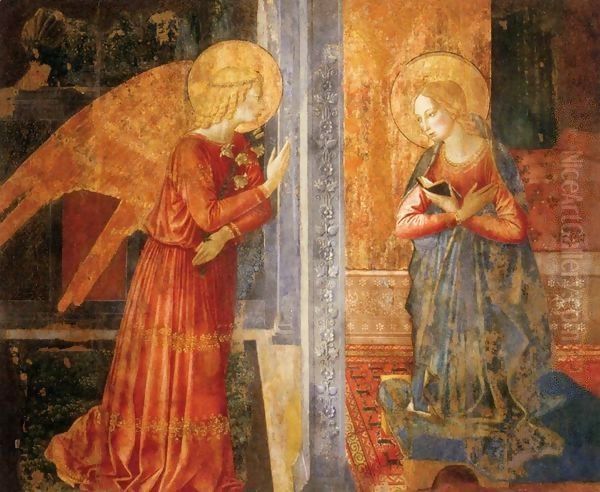
Benozzo Gozzoli's style is characterized by several key features. He was primarily a fresco painter, mastering the buon fresco technique (painting on wet plaster), which required speed and confidence. His greatest strength lay in narrative – he could tell a story clearly and engagingly, filling his scenes with lively action and relatable human gestures. Unlike the stark monumentality of Masaccio or the geometric precision of Piero della Francesca, Gozzoli's art delights in abundance and decoration.
His works are typically filled with intricate details: the patterns of rich textiles, the individual leaves on trees, the feathers of birds, the elaborate architecture of imagined cities. He possessed a keen eye for observation, particularly of the natural world, often incorporating charming depictions of animals and detailed landscapes that, while sometimes idealized, show a genuine interest in rendering the environment. His colour palette remained bright and appealing throughout his career, contributing to the festive and accessible quality of his art.
Nature and Realism in Gozzoli's Art
While deeply rooted in the narrative traditions of religious art, Gozzoli displayed a burgeoning Renaissance interest in the natural world and realistic detail. His landscapes, though often serving as backdrops, are rendered with care, depicting recognizable features of the Tuscan countryside – rolling hills, cypress trees, fortified towns. This attention to landscape went beyond mere setting; it added depth and context to his narratives.
His fascination with animals is particularly noteworthy. Horses, dogs, birds, and even exotic creatures like camels and cheetahs (as seen in the Magi Chapel) populate his frescoes. These are not mere symbols but are often depicted with a lively naturalism that suggests direct observation. This focus on the details of the created world, alongside the human drama, aligns with the broader Humanistic currents of the Renaissance, which encouraged a closer study of reality in all its forms.
Humanism and Florentine Society
Gozzoli's art provides a fascinating window into 15th-century Florentine society and the values of Early Renaissance Humanism. His tendency to include portraits of his patrons and prominent contemporaries within religious scenes (most famously in the Magi Chapel) reflects the era's blend of piety and civic pride. These works served not only devotional purposes but also functioned as statements of status, lineage, and political influence. The patrons saw themselves as part of the ongoing sacred narrative.
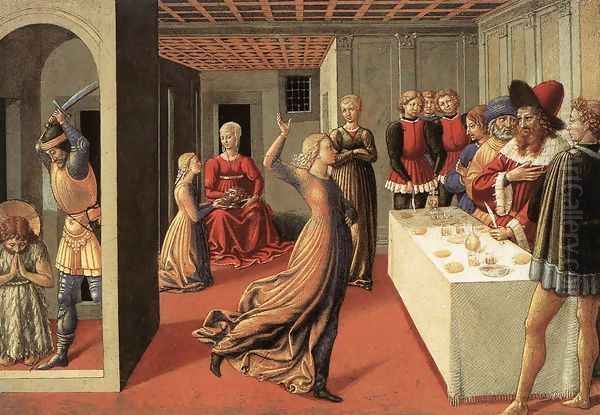
His detailed rendering of contemporary costumes, architecture, and landscapes grounded the biblical and hagiographic stories in the viewers' own world, making them more immediate and relatable. This focus on the human element, on individual likenesses, and on the richness of earthly life, even within religious contexts, is a hallmark of Renaissance Humanism. Gozzoli, while perhaps less intellectually profound than some contemporaries, perfectly captured the visual splendor and confident spirit of Medicean Florence. His narrative clarity made complex stories accessible, aligning with the Humanist emphasis on education and communication. His style can be compared to the slightly later Domenico Ghirlandaio, who also excelled at incorporating portraits and contemporary details into large fresco cycles.
Collaboration, Competition, and Reputation
The Florentine art world of the 15th century was a place of both collaboration and intense competition. Gozzoli's career reflects this reality. His early work alongside giants like Ghiberti and Fra Angelico demonstrates the importance of workshop practice and learning from established masters. He also collaborated with Fra Filippo Lippi, another major painter of the period, on projects such as decorations for the San Marco monastery in Florence. Lippi, a powerful influence on Florentine painting and teacher of Botticelli, existed in the same artistic milieu as Gozzoli.
However, success could also breed rivalry. There are anecdotal accounts, reported by Vasari, suggesting that Gozzoli faced jealousy from competitors, possibly even plots against him stemming from his success and numerous commissions. While difficult to verify, such stories hint at the high stakes and competitive pressures faced by artists vying for patronage and prestige. Gozzoli navigated this world successfully, securing major commissions across Tuscany and Umbria for decades. His contemporaries included artists pursuing different stylistic paths, such as the perspective-obsessed Paolo Uccello and the sculpturally powerful Andrea del Castagno, not to mention the towering influence of the sculptor Donatello.
Later Years and Enduring Influence
After completing the bulk of his work in Pisa, Gozzoli eventually returned closer to Florence. He spent his final years primarily in Pistoia, where he continued to work, though perhaps with less intensity than in his prime. He died in Pistoia in 1497, bringing a long and remarkably productive artistic life to a close. There is some uncertainty about his exact burial place, though tradition suggests the cloister of the San Domenico monastery in Pistoia.
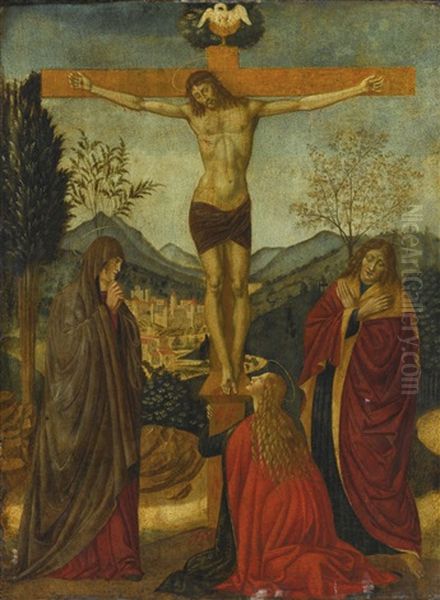
Benozzo Gozzoli's legacy is that of a master storyteller and a brilliant decorator. While not considered a radical innovator in the same vein as Masaccio or Donatello, his contribution to the richness and visual culture of the Early Renaissance is undeniable. He absorbed lessons from his teachers Ghiberti and Angelico and forged a distinctive style characterized by narrative clarity, vibrant colour, and an abundance of delightful detail. His frescoes, particularly the Magi Chapel, remain beloved highlights of Florentine art, offering an unparalleled glimpse into the world of the 15th century. His influence can be seen in the work of lesser-known followers, and his paintings stand alongside those of contemporaries like Perugino and Signorelli as major examples of large-scale narrative fresco decoration in the Quattrocento.
Conclusion: Chronicler of an Age
Benozzo di Lese di Sandro Gozzoli was more than just a skilled painter; he was a visual chronicler of his time. Through his extensive fresco cycles in Florence, Montefalco, San Gimignano, and Pisa, he brought sacred stories to life with a charm, detail, and vibrancy that resonated deeply with his contemporaries. His ability to weave together religious narrative, contemporary portraiture, detailed landscapes, and decorative richness created works that were both pious and worldly, reflecting the complex spirit of the Florentine Renaissance. From his early training with Ghiberti and Fra Angelico to his major independent commissions for patrons like the Medici, Gozzoli carved out a significant place in the history of Italian art. His frescoes remain enduring testaments to his narrative genius and his ability to capture the pageantry and confidence of 15th-century Italy.